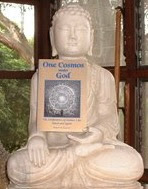The kingdom of heaven is like a mustard seed which a man took and planted in his field; it is the smallest of all seeds, but when it has grown it is the greatest of shrubs and becomes a tree, so that birds of the air come and nest in its branches.
A footnote in my Study Bible says that the mustard seed symbolizes the disciples who "began as just a few men, but soon 'encompassed the whole earth'" -- almost like Jesus knew this would eventually happen or something.
The seed also symbolizes "faith entering a person's soul, which causes an inward growth of virtue," such that he becomes increasingly godlike (AKA theosis).
And on the opposite page, I see that there is a whole section on parables, which are "stories in word-pictures, revealing spiritual truth." In Hebrew and Aramaic, the word is also related to allegory, proverb, and riddle.
With apologies to our godless friends, parables can function a bit like koans, which, according to the google machine, are paradoxical anecdotes or riddles used in Zen to demonstrate the inadequacy of logical reasoning and to provoke enlightenment.
In like fashion, parables "give us glimpses of Him whose thoughts are not our thoughts and whose ways are not our ways." The point is to vault us out of our habitual manner of thinking.
Which is why they require a bit of "work" on our end: the meaning "is not evident to all who hear them. The listener must have spiritual ears to hear, and even then not all have the same degree of understanding."
Parables are layered, as it were; or rather, we are layered, and therefore understand the parable according to our own depth.
The Study Bible cooncurs: the parables demonstrate that "people are responsible for their own lack of receptivity: having grown dull and insensitive," they are unwilling or unable to hear or accept the message.
Importantly, insight into them "does not come simply through an intellectual understanding"; rather, they are, as it were, relatively unsaturated containers into which a kind of higher understanding -- AKA faith -- may pour itself.
Rutler adverts to the intricacy -- and mystery -- of any seed. Jesus's "earthly contemporaries would have been confounded by the system that encodes in the first inkling of a life all that the organism will become.... A seed is alive, even if it looks like little more than lint," just as "the first cell of human life is alive" even if we call it a "blastocyst."
For Rutler, the seed represents the Church, "nascent and fragile" yet destined to reach over mountains, across oceans, and even through cultures, baptizing and transforming what is worthy and leaving the rest behind.
This despite the fact that "The little seedling did not seem to have much promise, and it seemed to die when it sprouted into a cross."
It seems that the seed is simultaneously incarnation, cross, and church, i.e., Body of Christ. Or, the sprawling Body of Christ is the mature plant that has grown from its tiny seedling.
Dávila has an arboreal aphorism that relates somewhat to the above: We cannot find shelter in the Gospel alone, as we also cannot take refuge in the seed of an oak tree, but rather next to the twisted trunk and under the disorder of the branches.
Which is why to fell sacred groves is to erase divine footprints.
Having said that, Souls that Christianity does not prune never mature.
Those three aphorisms add up to the idea that the seed is planted in time, which is why it is entirely bound up with history, which is to say tradition. History is the twisted trunk and tradition the unruly branches. Some Protestants would cut down the tree of tradition to try to get back to the seed, but that is to erase footprints the divine has left in history.
Nevertheless, prudent pruning is always advised. A couple of years ago a massive tree in my side yard split in two, because a huge branch had grown too large and too remote from the central trunk.
There's a parable in there somewhere....





























